C.Owers Hansa-Brandenburg Aircraft of WWI Vol.2: Biplane Seaplanes (A Centennial Perspective on Great War Airplanes 18)
The Van Berkel WA(49)
Neutral nations in World War I that bordered the warring states had to upgrade their military in order to defend their neutrality. The Netherlands was particularly sited that aircraft of the combatants often overflew its territory, and damaged combat aircraft would head into the Netherlands rather than be captured, and this does not include those that were lost through navigation error, landed and were interned. As a result the Netherlands utilised these aircraft where possible. Landplanes, the majority of internees, were used by the Luchtvaartafdeling (LVA) while the Navy's air arm, the Matineluchtvaartdienst (MLD) received only 17 aircraft that were considered useful enough to warrant serial numbers from this source. Of these 11 were purchased from their former owners.
On 31 October 1917, W.12 MN 1185 (160-hp Benz No. 26849) with crew of Flugobermaat Huthmacher and Ltn.z.S Zapp left Zeebrugge at 07.00. They became lost and ran out of fuel. They alighted on a flooded meadow that had looked like a lake from the air with hardly any damage. The crew then burned their aircraft. Zapp was interned but Huthmacher managed to evade his guards and escape back across the border. The remains were salvaged by the LVA and the motor was acquired by the MLD who most likely used it for spares.
W.12 MN 1398 (160-hp Benz No. 26851) was acquired on 6 December. The crew of Oblt.d.Res F. Hopken and Flugmaat J. Johannsen were returning from a reconnaissance patrol to the UK when they were forced down with engine trouble. The floatplane was badly damaged and the crew clung to the floats until they managed to attract the attention of the gas transport vessel Vlissingen by firing a flare. The Vlissingen transported gas to the lightship Noordhinder. The machine was picked up some 35 km west of Westkapelle after some 22 hours adrift. The floatplane was recovered, the Vlissingen having a relief crew aboard, but only the engine was salvageable and purchased. The crew was released as shipwrecked mariners.
Again, on 16 April 1918, W.12 MN 2035 (150-hp Benz No. 27087), with crew of Flugzeugmeister Hartmuth Frosch (or Trosch) and Flugmechanikermatt Antonie Hansen, was lost in fog and ended up on a beach at Scheveningen and was burned by the crew. The nearby Coast Guard station had not seen the machine due to the fog and arrived too late to save it from being destroyed. The Benz motor was purchased for f4,000.
On 22 April 1918, W.12 MN 2098 (160-hp Mercedes No. 34158), alighted south of Rottum Island due to the crew of Deckoffizier Alfred Walter and Flugobermaat Leonard Wuggazer, losing their way in fog and then suffering engine failure. The Coast Guard informed the MLD base at De Mok of the alighting and a team was sent to salvage the aircraft and bring it back to De Mok. The W.12 was on a sandbank and in full airworthy condition, so OMSD3 H.J. Takens decided to leave the aircraft intact and tow it to De Mok. This was against standing instructions that stated that interned aircraft were to be dismantled; however, Takens had no facilities to dismantle the machine. Fortuitously a sailing vessel came by and Takens commandeered this, the seaplane being hoisted aboard the vessel. The machine gun was removed and the German insignia covered up as much as possible.
Though Takens was praised for his initiative, he also had it pointed out to him that his actions may have had serious international consequences. The open transportation of a seaplane of one of the belligerent powers could have endangered Dutch neutrality. The machine was test flown by LTZ1 D. Vreede, the commanding officer of the MLD, who was impressed with the Brandenburg and as the acquisition of an up-to-date fighter seaplane was too good an opportunity for the MLD to miss, the incident was hushed up.
The machine was purchased from the German Navy for f25,000, and taken into the MLD with the serial W-1. This became the pattern aircraft for the construction of the Van Berkel WA.
A further W.12 identified as MN 2200 crashed near Terschelling on 2 October 1918.
The performance and seaworthiness of the Brandenburg led to a licence being obtained for its construction in the Netherlands.(50) The Trompenburg aircraft factory was fully committed to the production of Spijker trainers, and a new manufacturing concern was necessary in order to undertake the production of the W.12. W.A. van Berkel was the successful owner of the Van Berkel Patents firm(51) and was prepared to undertake the risk of starting an aircraft manufacturing plant. Late in 1918 the factory was established at Keileweg 9, Rotterdam. The company was given a contract for 35 Brandenburg floatplanes on 15 November 1918. The contract signed by the Munitions Office and the Company was for the production of slicing machines according to Van Berkel's Patent and other tools. Why the seaplanes had to be concealed has not been revealed. They were to be equipped with the 200-hp Hispano-Suiza engine, that Van Berkel was also to manufacture under licence and be completely airworthy. The machine had to have provision for mounting two machine guns, one for the observer and a synchronised one for the pilot.
Article 10 stated that the machine should be able to perform the same requirements of speed, climb, etc., as the seaplane V-3, when both were in the fully loaded condition. The W.12 serial W.1 had crashed and so could no longer be used for comparison purposes, therefore the Friedrichshafen FF33L, ex-MN 1581, that had been interned on 24 September 1917, and given the MLD serial V-3, was to be used instead.
The production of the engines did not proceed well. The processes involved proved to be fraught with problems. The castings for the engines proved highly porous and were rejected. The program was terminated.
The W.12 produced by van Berkel was named the WA after Mr. van Berkel. After a slow start things progressed better when a number of German workmen from Friedrichshafen were engaged. Takens was placed as supervisor for the Navy. The debacle of the Hispano-Suiza engines meant that another source of engines had to be found, and at van Berkel's request Takens went to Germany to obtain suitable engines. With the help of a Mr. Bruno Jablonsky, one hundred second-hand Mercedes D.IIIau engines were obtained at Tempelhof. Sixty were for the Navy with the others going to the LVA. Takens had also obtained a complete test rig from Germany. Apparently Fokker had offered BMW engines but the Mercedes were preferred as they had a better altitude performance. This comment is interesting in the light of future events. The total price including engines and propellers was 35,050 Dutch guilders.
Due to the turmoil in Germany the engines could not be tested there and when the first engine was given a test run in the Netherlands, its output was less than the rated 180-hp. It appeared that the "duramen Hollander" had been sold a bunch of "ill fed horses." However Takens solved the problem by modifying the exhaust collector and the engines performed above their rated horsepower. With the engine problem solved and Mr. Carl Lesch engaged as test pilot, the program got under way in mid-1919.
The first WA was exhibited at the ELTA exhibition in Amsterdam. It was to be used for sand loading testing. The second machine was sent in a dismantled state to the MLD base at Schellingwoude, where it was tested on 6 September 1919, by LTZ1 H. Nieuwenhuis with Takens in the rear cockpit, becoming the first WA to fly. The performance was so good that they decided to fly to Rotterdam that afternoon. Van Berkel, always good for publicity, had notified the populous of the intending flight by placing bulletins in cafes and tobacco shops. Nieuwenhuis made circuits over the ELTA exhibition before flying to Rotterdam. By the time they landed a big crowd had gathered. After refreshing themselves from Van Berkel's Patent's motorboat, the pair took off and returned to Amsterdam.
W-1 and W-2 were accepted in October and in November were crated and sent to the Netherlands East Indies (NEI). The NEI received W-1 to W-12, W-12a, and W-14 to W-20. Although 13 was used in serial designations, for the WA it was not used and 12a substituted instead. The NEI also had W-21c that was built at the MLD station Morokrembangan, Surabaya, from the remains of W-11 and W-19. The wooden floats were not up to the conditions suffered in the NEI and aluminium floats built by the Dornier works at Friedrichshafen replaced them.
The NEI was a vast archipelago comprising many islands spread over many hundreds of square kilometers of sea. These islands with their sheltered bays and inlets were ideal for the operation of seaplanes as the Japanese would demonstrate in World War II. The MLD had tried previously in 1918 to employ seaplanes by shipping a Friedrichshafen and Rumpler seaplane to the area, but both were wrecked and written off in 1920.
Eight destroyers were modified to carry a WA on the stern. All new ships had to be able to carry an aircraft. This greatly extended the range in which the WA floatplanes could operate. The machines were used for hydrographic duties, spotting reefs, medical services by flying needed medical supplies into isolated areas, showing the flag, and giving local leaders flights to increase their local prestige. All this was in addition to their normal naval duties of spotting for the fleet. The only disadvantage of the WA in the NEI was its short range. The floatplanes were based at the old Army seaplane station at Tandjong Priok, and later Surabaya. Due to the fact that the aircraft could not make the trip between the two stations in one flight, an auxiliary base was established at Semarang.
In the Netherlands serials W-51 to W-70 were allocated to WA floatplanes. However, it is thought that W-66 to W-70 were actually built by the MLD. The repair shops at De Kooy would often build complete aircraft from the remains of wrecked aircraft and spares. For example the wreck of W-63 was transported to De Kooy by barge; that same day a brand-new W-63 was transported back from De Kooy.
In October 1924 a steel-tube fuselage was built for the WA at De Kooy, and proved successful. Thereafter all WA biplanes were given a fabric-covered steel fuselage when in for repair. W-67 was written off in July 1930, the last of the wooden fuselage WA biplanes. The type continued to serve until 1934 when they were finally retired. Only three fatal crashes concerned the WA; however, in all cases both crewmen were killed.
- W-57 on 28 September 1925, near Den Helder.
- W-16 on 2 June 1927, in the Java Sea.
- W-54 on 2 September 1930, at the Loosdrecht Lakes.
As in the NEI ships were adapted to carry the WA biplanes, in the Netherlands the ironclads HMS Hertog Hendrick and HMS Jacob van Heemskerk were modified to carry aircraft.
The WA could mount a 7.7 mm Vickers machine gun on the gun ring. This was never carried on fleet exercises. When not in use the gun could be lowered into a slot in the fuselage that was covered by an aluminium panel. Despite the contract calling for a synchronised gun for the pilot this was never fitted to the WA.
During its long service the WA had many modifications. The metal fuselage with fabric covering and metal floats has been mentioned above. From 1927 dural floats were used in the Netherlands.
From 1925 the Mercedes engines were replaced during overhaul with the 185-hp BMW IIIa six-cylinder inline engine. The wing mounted radiator was replaced by a car type radiator mounted in the nose.
Both in the Netherlands and the NEI the tailplane had a double set of supporting struts. No reason is given for their fitting as the original German machines did not require any additional bracing.
A larger rudder was introduced to help with taxying. Following the introduction of the more powerful BMW engine the elevator balance and tailplane area were increased in late 1926 to overcome instability in flight due to the new engine.
The Netherlands Navy requested a two-seat long-range monoplane similar to the Brandenburg W.29. Baumhauer designed a monoplane for Van Berkel that was a completely new design of larger proportions and powered by a Rolls Royce Eagle VIII engine. Six of these WB monoplanes were built and are often referred to as Brandenburgs, but apart from some superficial similarities, the WB was a completely new design. The WB was the last aircraft built by Van Berkel.
(49) This section has been written in the main from the researches of Fritz Gerdessen.
(50) This section has been written in the main from material supplied by the Netherlands Bureau Maritieme Historie, translated by Fritz Gerdessen.
(51) Wilhelmus Adrianos Van Berkel successfully patented, manufactured and sold meat slicing and weighing machines. He was internationally famous and rich by the time of the war. His firm made rifles and ammunition for the Dutch Army after the outbreak of the war. He always produced to specification and had a good reputation with the military.
Van Berkel Patents WA Specifications
Source Bureau Maritieme Historie MLD Type WA 3-View
Dimensions in m
Span, Upper 11.17 11.270
Span, Lower 9.60(52) 9.475
Length - 9.475
Height 3.35 4.250 (incl. rad.)
Wing Area, m2 36.20(53) -
Empty Wt., kg 997 -
Mil. Load, kg 230 -
Loaded Wt., kg 1,454 -
Performance
Max. Speed 135 km/h -
Cruise Speed 120 km/h 6 min.
Time to 1000 m 7 min. 8 min.
Time to 1525 m - 13 min.
Time to 2000 m 18.9 min. 20 min.
Time to 3000 m - 38 min.
Service Ceiling 4,500 m -
Range at Cruise 580 km -
Engine Mercedes D.IIIau -
(52) According to "Van Berkel seaplanes" by N. Geldhof, (Air Britain Digest, Summer 1995, P.43), the span of the lower wing was 10.49 m. All other dimensions quoted are the same as those quoted in the Bureau Maritieme Historie paper.
(53) An article in de Modelbouwer gives an area of 35 m2.
Журнал Flight
Flight, August 28, 1919.
THE E.L.T.A. SHOW
The only other Dutch machine exhibited is that built by
VAN BERKELS PATENT, HOLLAND.
This is a twin-float seaplane, shown at the exhibition without engine, but intended, we believe, for a Mercedes. The fuselage is built up of a light framework covered with three-ply wood. The ply-wood covering of the rear portion of the fuselage is continued outwards over the tail plane, which latter is built integral with the body. The fuselage is very deep at the rear, where as a matter of fact it performs the function of a fin, no other vertical fin being fitted. As the tail plane is at the top of the fuselage the whole tail looks somewhat unusual, especially as the rudder has its balanced portion projecting below the stern instead of, as in the majority of machines, above it.
The two floats, which are of the single step type, are flat-bottomed as regards their front portion, but to the rear of the step the bottom gradually changes from flat to Vee bottom, finally coming to a point at the heel of the float. The construction is very similar to that of the fuselage, brass screws and nails being used throughout. The floats are, of course, fitted with water-tight bulkheads, easily detachable inspection doors being provided in the deck for examining the interior.
The wing bracing of this seaplane is unusual, in that there is only one pair of struts on each side, in spite of the comparatively large span. The upper plane is of slightly greater span than the bottom one, and the inter-plane struts slope outwards to obtain the best load distribution on the respective spars. The lift and landing loads are taken by tubes sloping from the floats outward to the lower surface of the bottom plane at the points where occur the inter-plane struts. As the float strut formation is in the shape of a letter M, as seen from in front, and having a transverse horizontal strut between the floats, the outward component of the lift pull on the sloping struts is transmitted to this horizontal strut, which is therefore in tension when the machine is flying, and probably in slight compression when the machine is at rest. We understand that this machine has not yet flown, but a speed of 155 km. per hour is estimated for her.
Another exhibit on this stand which attracts attention is a small 8-cyl. rotary engine of the two-stroke type. It was, we learn, designed by Mr. Kerner, of the technical staff of Van Berkels. Its chief feature is that, in order to avoid the trouble experienced in all two-stroke engines at certain speeds - either a mixing of the fresh charge with residual gases, or a waste of fuel through blowing part of the fresh charge out through the exhaust ports - a small piston disc is interposed between the fresh charge and the exhaust gases, thus preventing them from mixing, while at the same time being limited in travel so as to prevent the escape of the fresh gas through the exhaust ports. This piston disc is mechanically operated, but we were unable to ascertain the details of the mechanism. The Kerner engine is provided with external inlet pipes, and very large inlet valves are fitted in the cylinder heads. We understand that the engine has passed through satisfactory test runs, and it is claimed to develop 120 h.p. for a weight of 95 kgs.
 |
C.Owers - Hansa-Brandenburg Aircraft of WWI. Volume 2 - Biplane Seaplanes /Centennial Perspective/ (18)
|
| Van Berkel WA W.3. Surubaya, Dutch East Indies ca. 1919-20
|
 |
C.Owers - Hansa-Brandenburg Aircraft of WWI. Volume 2 - Biplane Seaplanes /Centennial Perspective/ (18)
|
| Van Berkel WA W59 Netherlands Naval Air Service 1921
|
 |
C.Owers - Hansa-Brandenburg Aircraft of WWI. Volume 2 - Biplane Seaplanes /Centennial Perspective/ (18)
|
| Van Berkel WA W67 Netherlands Naval Air Service 1920s
|
 |
C.Owers - Hansa-Brandenburg Aircraft of WWI. Volume 2 - Biplane Seaplanes /Centennial Perspective/ (18)
|
| Another view of the first van Berkel WA.
|
 |
C.Owers - Hansa-Brandenburg Aircraft of WWI. Volume 2 - Biplane Seaplanes /Centennial Perspective/ (18)
|
| The first van Berkel WA, virtually an exact copy of the Brandenburg W.12. This machine was shown at the 1919 ELTA Exhibition then tested to destruction without ever being flown.
|
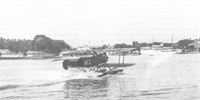 |
C.Owers - Hansa-Brandenburg Aircraft of WWI. Volume 2 - Biplane Seaplanes /Centennial Perspective/ (18)
|
| Note how the white serial includes the period - W.3 in Surabaya Harbor. The fabric is doped a dark grey color with the early orange circle national markings applied in the usual positions. The ply horizontal tailplane shows up well in this photograph.
|
 |
C.Owers - Hansa-Brandenburg Aircraft of WWI. Volume 2 - Biplane Seaplanes /Centennial Perspective/ (18)
|
| Van Berkel WA serial W 5 with the late type of national markings that were still in use. Note the windscreen to the observer's cockpit, radiator and associated plumbing, and tube under the fuselage with weighted aerial hanging from its end. The first 20 machines were sent to the Dutch East Indies for use by the MLD.
|
 |
C.Owers - Hansa-Brandenburg Aircraft of WWI. Volume 2 - Biplane Seaplanes /Centennial Perspective/ (18)
|
| W 5 and W 7 both went to the Dutch East Indies to serve with the KNIL.
|
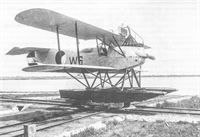 |
C.Owers - Hansa-Brandenburg Aircraft of WWI. Volume 2 - Biplane Seaplanes /Centennial Perspective/ (18)
|
| The tracks for launching the seaplanes have points at each intersection where the track crosses the track to the water. W 6 shows the large center section cut-out used on the WA.
|
 |
C.Owers - Hansa-Brandenburg Aircraft of WWI. Volume 2 - Biplane Seaplanes /Centennial Perspective/ (18)
|
| W 16 and W 9 are loaded on the stern of a minelayer. The minelayers HMS Siboga and ??? are known to have carried WA aircraft.
|
 |
C.Owers - Hansa-Brandenburg Aircraft of WWI. Volume 2 - Biplane Seaplanes /Centennial Perspective/ (18)
|
| "W.52." appears to be in a canal. The upper surfaces of the wings appears to be darkly colored. Note the generator on the top wing.
|
 |
C.Owers - Hansa-Brandenburg Aircraft of WWI. Volume 2 - Biplane Seaplanes /Centennial Perspective/ (18)
|
| W 52 taxiing along a Kanall (the Noordhollands Kanaal?).This machine is in the early color scheme with the orange circle national marking applied to fuselage and wings. The rudder is orange. (AHT AL0548-049)
|
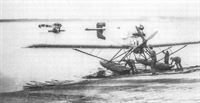 |
C.Owers - Hansa-Brandenburg Aircraft of WWI. Volume 2 - Biplane Seaplanes /Centennial Perspective/ (18)
|
| The van Berkel WB monoplane borrowed much from the Brandenburg designs but was a completely new indigenous design. WA 54 floats in the background. Rudders of both seaplanes are orange.
|
 |
C.Owers - Hansa-Brandenburg Aircraft of WWI. Volume 2 - Biplane Seaplanes /Centennial Perspective/ (18)
|
| The suspended W 54 is the backdrop to this gathering of guards, with their rifles, naval aviators and two civilians. This floatplane was lost in a fatal accident on 2 September 1930 on the Loosdrecht Lakes. There were only three fatal crashes of the WA and in all cases both crewmen were killed.
|
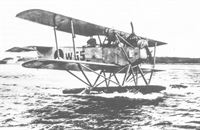 |
C.Owers - Hansa-Brandenburg Aircraft of WWI. Volume 2 - Biplane Seaplanes /Centennial Perspective/ (18)
|
| W 55 displays the fuselage stringer that indicates that it has a metal tube fuselage. Note the frontal radiator.
|
 |
C.Owers - Hansa-Brandenburg Aircraft of WWI. Volume 1 - Landplanes /Centennial Perspective/ (17)
|
| The van Berkel WA was a version of the Brandenburg W.12 fighter that was developed in the Netherlands post-WWI. The type would serve in home waters and in the Dutch East Indies. The Netherlands was only one country that manufactured Brandenburg designs post-war.
|
 |
C.Owers - Hansa-Brandenburg Aircraft of WWI. Volume 2 - Biplane Seaplanes /Centennial Perspective/ (18)
|
| This sequence was taken when W 59 was undertaking trials in the Noordhollands Kanaal in 1921. Note the Naval personnel on bicycles. (AHT AL0548-029; -044, -045 & -048)
|
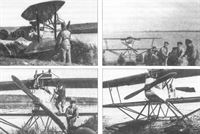 |
C.Owers - Hansa-Brandenburg Aircraft of WWI. Volume 2 - Biplane Seaplanes /Centennial Perspective/ (18)
|
| This sequence was taken when W 59 was undertaking trials in the Noordhollands Kanaal in 1921. Note the Naval personnel on bicycles. (AHT AL0548-029; -044, -045 & -048)
|
 |
C.Owers - Hansa-Brandenburg Aircraft of WWI. Volume 2 - Biplane Seaplanes /Centennial Perspective/ (18)
|
| W 60 has the fuselage stringer that indicates that it has a metal tube, fabric covered fuselage. The machine including the pontoons, is painted a light grey color. Wooden pontoons were panted light grey, dural ones were painted black. The dural floats were constructed by Dornier at Friedrichshafen.
|
 |
C.Owers - Hansa-Brandenburg Aircraft of WWI. Volume 2 - Biplane Seaplanes /Centennial Perspective/ (18)
|
| W 63 in flight. Note the large rudder. The exact number of WA seaplanes built cannot be accurately determined due to the MLD reconstructing machines. For example when the wreck of W 63 arrived at De Kooyk by barge, on the same day a new W 63 was transported back to De Mook.
|
 |
C.Owers - Hansa-Brandenburg Aircraft of WWI. Volume 2 - Biplane Seaplanes /Centennial Perspective/ (18)
|
| W 64 on the water. Note the large cut-out in the center section.
|
 |
C.Owers - Hansa-Brandenburg Aircraft of WWI. Volume 2 - Biplane Seaplanes /Centennial Perspective/ (18)
|
| A pilot is in the cockpit of W 64 that has the early national insignia applied. (AHT AL0548-042)
|
 |
C.Owers - Hansa-Brandenburg Aircraft of WWI. Volume 2 - Biplane Seaplanes /Centennial Perspective/ (18)
|
| W 66 in better condition. Note the position of the later national insignia. It is thought that W 66 was built by the MLD at De Kooy. It has the two tailplane support struts that were not fitted on the prototype and early production aircraft.
|
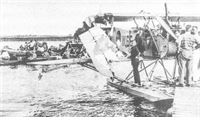 |
C.Owers - Hansa-Brandenburg Aircraft of WWI. Volume 2 - Biplane Seaplanes /Centennial Perspective/ (18)
|
| No details are known about this accident to W 66. Note the additional two center section struts that were fitted to the front of the machine when they were fitted with the 185-hp BMW IIIA engine with frontal radiator.
|
 |
C.Owers - Hansa-Brandenburg Aircraft of WWI. Volume 2 - Biplane Seaplanes /Centennial Perspective/ (18)
|
| Van Berkel W 67 has dark floats and struts. Noteworthy are the position of the radiator high up on the center section, transparent panels under the fuselage and other differences from the Brandenburg factory produced W.12. W 67 was the last WA that had the Brandenburg type ply fuselage. It was lost in a crash in July 1930 before it could receive a new fabric covered, steel tube fuselage.
|
 |
C.Owers - Hansa-Brandenburg Aircraft of WWI. Volume 2 - Biplane Seaplanes /Centennial Perspective/ (18)
|
| The Dutch used their WA floatplanes from ships.This scene in the Dutch East Indies shows a van Berkel WA approaching the ship's crane.
|
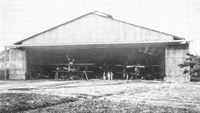 |
C.Owers - Hansa-Brandenburg Aircraft of WWI. Volume 2 - Biplane Seaplanes /Centennial Perspective/ (18)
|
| This photograph was taken in the Dutch East Indies, probably the KNIL base Morokrembangan, at Surabaya. KNIL van Berkel WA biplanes W 12, W 16, W 4 and W 5 can be identified in the hangar on the original photograph. (AHT AL0548-182)
|
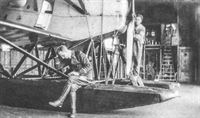 |
C.Owers - Hansa-Brandenburg Aircraft of WWI. Volume 2 - Biplane Seaplanes /Centennial Perspective/ (18)
|
| A Dutch officer sits on the pontoon of a van Berkel WA while the machine is undergoing maintenance. The open cockpit door displays the light internal color, probably white, the same as the German originals used. (AHT AL0548-189)
|
 |
Журнал - Flight за 1919 г.
|
| Van Berkels Patent: On this stand is shown a twin-float seaplane without inter-plane wing bracing, the lift being taken by tubes from the floats. This machine was shown minus engine.
|






























